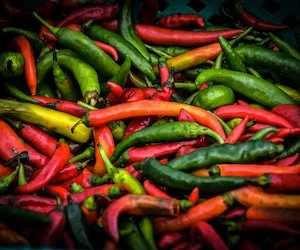
Growing Peppers at Home: Tips and Tricks for a Bountiful Harvest
Are you a pepper lover who dreams of having a bountiful harvest of fresh and flavorful peppers right in your own backyard? Look no further! In this guide, we will share with you the top tips and tricks for growing peppers at home, ensuring a successful and abundant harvest. From choosing the right pepper varieties to providing optimal growing conditions, we will cover all the essential steps to help you become a master pepper grower. Discover the secrets to starting your pepper plants from seeds, caring for them throughout the growing season, and dealing with common pests and diseases. Whether you have a spacious garden or a small balcony, we will provide expert advice on container gardening and maximizing your pepper production. Get ready to enjoy the satisfaction of plucking vibrant peppers from your own garden and adding that fresh and zesty touch to your favorite dishes. Let’s dive in and unlock the secrets to growing peppers at home!
Growing peppers at home comes with a plethora of benefits that go beyond the convenience of having fresh produce at your fingertips. Firstly, homegrown peppers are bursting with flavor compared to store-bought ones. You have the freedom to choose from a wide variety of pepper types, from the mild and sweet bell peppers to the fiery habaneros. By growing your own peppers, you can experiment with different flavors, colors, and levels of heat. Furthermore, homegrown peppers are free from harmful pesticides, ensuring that you and your family are consuming healthy and safe produce. Additionally, growing peppers at home can be a rewarding and therapeutic experience. It allows you to connect with nature, relieve stress, and develop a sense of accomplishment as you watch your plants thrive and produce an abundance of peppers.
When it comes to growing peppers at home, there is a wide range of varieties to choose from. It’s important to consider your personal taste preferences, culinary needs, and the growing conditions in your area. Some popular pepper types for home gardens include bell peppers, jalapenos, serranos, habaneros, and cayenne peppers. Bell peppers are known for their sweet and crisp flesh, making them perfect for salads, stir-fries, and roasting. Jalapenos offer a mild to moderate heat level and are commonly used in salsas, nachos, and stuffed pepper recipes. Serranos and habaneros are hotter varieties that add a fiery kick to dishes like hot sauces, chili, and spicy marinades. Cayenne peppers are often dried and ground into a powder, adding heat and flavor to a variety of dishes. Consider your taste preferences and the dishes you enjoy cooking when selecting the pepper varieties to grow at home.
Peppers thrive in warm and sunny conditions, so choosing the right location for your pepper plants is crucial. Find a spot in your garden or on your balcony that receives at least 6-8 hours of direct sunlight per day. Ensure that the location is sheltered from strong winds, as the fragile pepper plants can be easily damaged. If you have limited space, consider growing peppers in containers that can be placed in the sunniest spots on your balcony or patio. Optimal growing temperatures for peppers range between 70-85°F (21-29°C), so make sure to choose a location that provides the necessary warmth for your plants to flourish. Additionally, peppers require well-draining soil to prevent waterlogged roots, so avoid planting them in areas prone to water accumulation.
Before planting your pepper seeds or seedlings, it’s important to prepare the soil to provide the best growing conditions for your plants. Start by removing any weeds or debris from the planting area. Peppers prefer slightly acidic soil with a pH level between 6.0-6.8. Test your soil’s pH level using a soil testing kit available at garden centers or online. If the pH level is too low, you can raise it by adding lime to the soil. If the pH level is too high, you can lower it by adding sulfur or organic matter such as compost or peat moss. Incorporate the amendments into the top 6-8 inches of soil to ensure they are well-mixed and evenly distributed. This will provide your pepper plants with the right balance of nutrients and a favorable pH level, promoting healthy growth.
Once you have prepared the soil, it’s time to plant your pepper seeds or seedlings. If you choose to start your peppers from seeds, sow them indoors 8-10 weeks before the last frost date in your area. Use seed trays or small pots filled with seed-starting mix, which provides a light and well-draining medium for the seeds to germinate. Plant the seeds at a depth of ¼ inch and keep the soil consistently moist until the seedlings emerge. Once the seedlings have developed their first set of true leaves, you can transplant them into larger pots or into your garden. If you prefer to start with seedlings, you can purchase them from a local nursery or garden center. When transplanting seedlings, make sure to space them at least 18-24 inches apart to allow for proper air circulation and growth.
Watering is a crucial aspect of pepper plant care, as both overwatering and underwatering can negatively impact their growth. Peppers require regular and consistent moisture, especially during the hot and dry summer months. Water your pepper plants deeply, ensuring that the soil is evenly moist but not waterlogged. Mulching around the base of the plants can help retain moisture and suppress weed growth. Additionally, peppers benefit from regular feeding to ensure healthy growth and abundant fruiting. Apply a balanced fertilizer every 4-6 weeks, following the package instructions for the correct dosage. Avoid over-fertilizing, as it can lead to excessive foliage growth at the expense of fruit production. Pruning pepper plants is not necessary but can help promote airflow, reduce the risk of disease, and improve overall plant health. Remove any damaged or diseased leaves or branches as they appear.
While peppers are relatively resistant to pests and diseases, they can still face some challenges. Aphids, pepper maggots, and flea beetles are common pests that can infest pepper plants. To control these pests, consider using natural remedies like insecticidal soaps, neem oil, or introducing beneficial insects such as ladybugs or lacewings. Diseases like bacterial spot, powdery mildew, and blossom end rot can also affect pepper plants. Ensure proper air circulation, avoid overhead watering, and remove any infected plant material to prevent the spread of diseases. If necessary, you can use organic fungicides or consult with a local extension service for specific recommendations based on your region.
As your pepper plants mature, it’s time to harvest your homegrown peppers. Peppers can be harvested at various stages of ripeness, depending on your desired flavor and use. Most peppers are ready to be picked when they have reached their full size and have developed their characteristic color. Use a sharp pair of garden shears or scissors to cut the pepper off the plant, leaving a short stem attached. Avoid pulling or twisting the peppers, as it can damage the plant. After harvest, peppers can be stored in the refrigerator for up to two weeks. For long-term storage, you can also freeze peppers by washing, slicing, and removing the seeds before placing them in airtight bags or containers. Another option is to pickle or can your peppers to enjoy their flavor throughout the year.
One of the joys of growing peppers at home is the opportunity to incorporate them into your favorite recipes. Whether you enjoy the mild sweetness of bell peppers or the fiery heat of habaneros, there are endless possibilities to explore. Add diced peppers to omelets, fajitas, or stir-fries for a burst of flavor and color. Roast peppers and use them in sandwiches, salads, or as a topping for pizzas. Make homemade salsas, hot sauces, or pickled peppers to elevate your meals. Experiment with stuffing peppers with a variety of fillings like cheese, rice, or ground meat. The options are endless, and the vibrant flavors of homegrown peppers will undoubtedly enhance your culinary creations.
Despite your best efforts, you may encounter some challenges during your pepper cultivation journey. If your pepper plants are not setting fruit, it could be due to inadequate pollination, extreme temperatures, or nutrient imbalances. Consider hand-pollinating the flowers using a small paintbrush or gently shaking the plants to distribute the pollen. To prevent blossom end rot, which appears as dark, sunken spots on the bottom of the peppers, ensure consistent moisture levels and avoid over-fertilizing. If you notice yellowing leaves, stunted growth, or wilting, it could indicate a nutrient deficiency or root rot. Adjust your watering and fertilizing practices accordingly and consider conducting a soil test to identify any nutrient deficiencies. If you are unsure about a specific issue, reach out to your local extension service or gardening community for expert advice and support.
Growing peppers at home is a rewarding and fulfilling experience that allows you to enjoy the freshest and most flavorful peppers right in your own backyard. By following the tips and tricks outlined in this guide, you will be well-equipped to start your pepper-growing journey. From selecting the right pepper varieties to providing optimal growing conditions, caring for your plants, and dealing with common challenges, you now have the knowledge to become a master pepper grower. Embrace the joys of pepper cultivation, experiment with different flavors and recipes, and savor the satisfaction of plucking vibrant peppers from your own garden. Get ready to elevate your culinary creations with the zesty and vibrant flavors of homegrown peppers!
